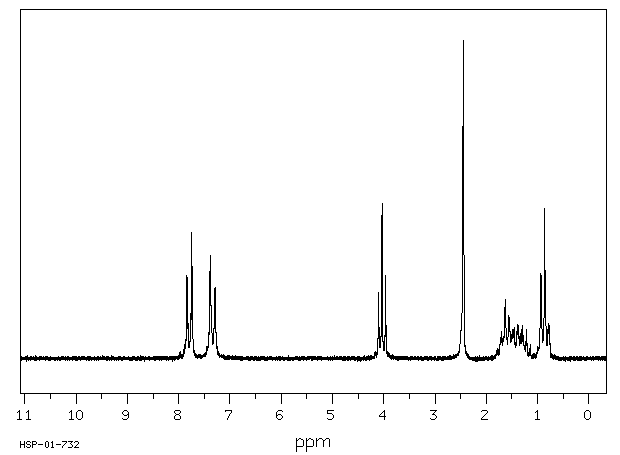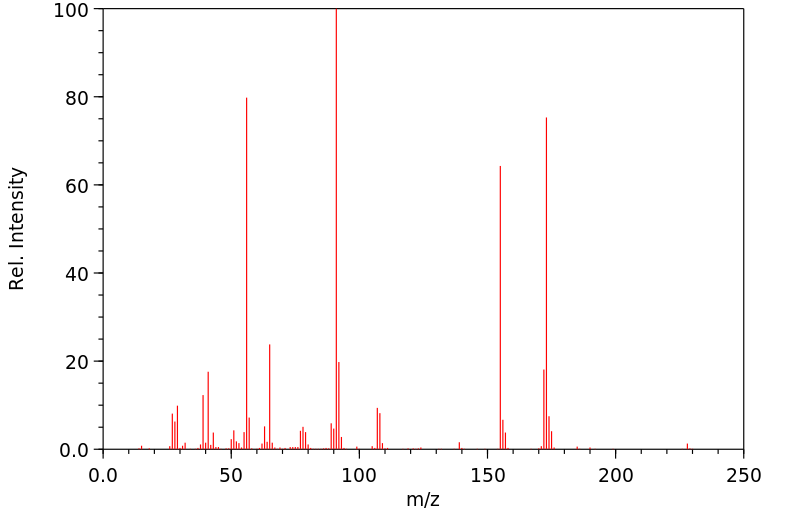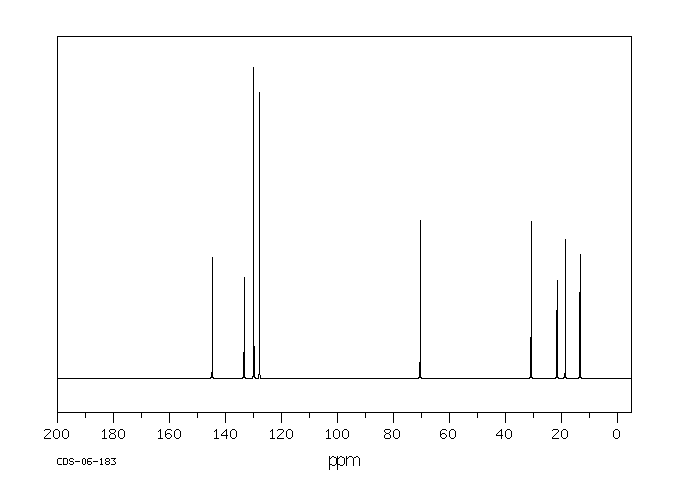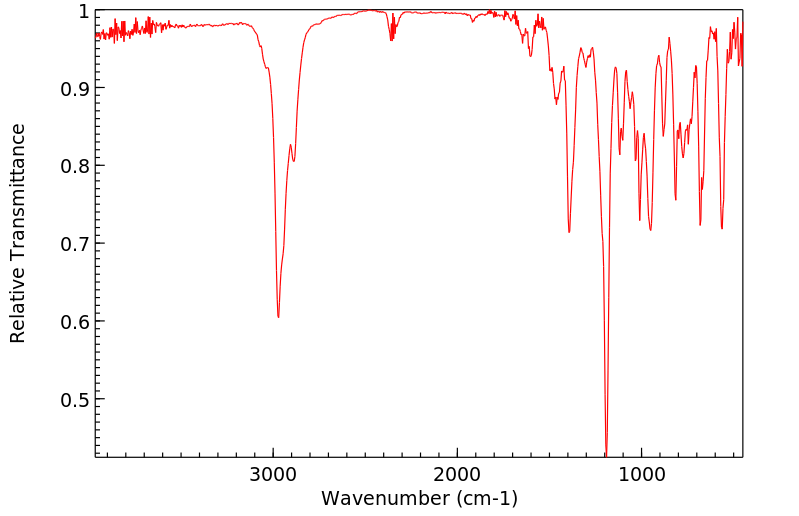对甲苯磺酸正丁酯 | 778-28-9
中文名称
对甲苯磺酸正丁酯
中文别名
4-甲基苯磺酸丁酯;对甲苯磺酸N-丁基酯;正丁基对甲苯磺酸;对甲苯磺酸n-丁酯;对甲苯磺酸丁酯
英文名称
butyl para-toluenesulfonate
英文别名
n-butyl tosylate;butyl 4-methylbenzenesulfonate
CAS
778-28-9
化学式
C11H16O3S
mdl
MFCD00027203
分子量
228.312
InChiKey
QYJXDIUNDMRLAO-UHFFFAOYSA-N
BEILSTEIN
——
EINECS
——
-
物化性质
-
计算性质
-
ADMET
-
安全信息
-
SDS
-
制备方法与用途
-
上下游信息
-
文献信息
-
表征谱图
-
同类化合物
-
相关功能分类
-
相关结构分类
物化性质
-
沸点:170-172 °C (10 mmHg)
-
密度:1.12
-
溶解度:可溶于氯仿(少量)、DMSO(少量)
-
LogP:2.8 at 20℃
-
稳定性/保质期:
在常温常压下保持稳定,应避免与强氧化剂接触。
计算性质
-
辛醇/水分配系数(LogP):2.7
-
重原子数:15
-
可旋转键数:5
-
环数:1.0
-
sp3杂化的碳原子比例:0.454
-
拓扑面积:51.8
-
氢给体数:0
-
氢受体数:3
安全信息
-
危险品标志:Xn
-
安全说明:S26,S37/39
-
危险类别码:R22,R36/37/38
-
海关编码:29041000
-
RTECS号:XT6400000
-
危险性防范说明:P280,P305+P351+P338
-
危险性描述:H302
-
储存条件:请将容器密封保存,并存放在阴凉、干燥的地方。
SDS
对甲苯磺酸丁酯
模块 1. 化学品
产品名称: Butyl p-Toluenesulfonate
模块 2. 危险性概述
GHS分类
物理性危害 未分类
健康危害 未分类
环境危害 未分类
GHS标签元素
图标或危害标志 无
信号词 无信号词
危险描述 无
防范说明 无
模块 3. 成分/组成信息
单一物质/混和物 单一物质
化学名(中文名): 对甲苯磺酸丁酯
百分比: >97.0%(GC)
CAS编码: 778-28-9
俗名: p-Toluenesulfonic Acid Butyl Ester
分子式: C11H16O3S
模块 4. 急救措施
吸入: 将受害者移到新鲜空气处,保持呼吸通畅,休息。若感不适请求医/就诊。
皮肤接触: 立即去除/脱掉所有被污染的衣物。用水清洗皮肤/淋浴。
若皮肤刺激或发生皮疹:求医/就诊。
眼睛接触: 用水小心清洗几分钟。如果方便,易操作,摘除隐形眼镜。继续清洗。
如果眼睛刺激:求医/就诊。
食入: 若感不适,求医/就诊。漱口。
紧急救助者的防护: 救援者需要穿戴个人防护用品,比如橡胶手套和气密性护目镜。
模块 5. 消防措施
合适的灭火剂: 干粉,泡沫,雾状水,二氧化碳
不适用的灭火剂: 棒状水
对甲苯磺酸丁酯
模块 5. 消防措施
特殊危险性: 小心,燃烧或高温下可能分解产生毒烟。
特定方法: 从上风处灭火,根据周围环境选择合适的灭火方法。
非相关人员应该撤离至安全地方。
周围一旦着火:如果安全,移去可移动容器。
消防员的特殊防护用具: 灭火时,一定要穿戴个人防护用品。
模块 6. 泄漏应急处理
个人防护措施,防护用具, 使用个人防护用品。远离溢出物/泄露处并处在上风处。确保足够通风。
紧急措施: 泄露区应该用安全带等圈起来,控制非相关人员进入。
环保措施: 防止进入下水道。
控制和清洗的方法和材料: 用合适的吸收剂(如:旧布,干砂,土,锯屑)吸收泄漏物。一旦大量泄漏,筑堤控
制。附着物或收集物应该立即根据合适的法律法规废弃处置。
模块 7. 操作处置与储存
处理
技术措施: 在通风良好处进行处理。穿戴合适的防护用具。防止烟雾产生。处理后彻底清洗双手
和脸。
注意事项: 如果蒸气或浮质产生,使用通风、局部排气。
操作处置注意事项: 避免接触皮肤、眼睛和衣物。
贮存
储存条件: 保持容器密闭。存放于凉爽、阴暗处。
远离不相容的材料比如氧化剂存放。
包装材料: 依据法律。
模块 8. 接触控制和个体防护
工程控制: 尽可能安装封闭体系或局部排风系统,操作人员切勿直接接触。同时安装淋浴器和洗
眼器。
个人防护用品
呼吸系统防护: 防毒面具。依据当地和政府法规。
手部防护: 防护手套。
眼睛防护: 安全防护镜。如果情况需要,佩戴面具。
皮肤和身体防护: 防护服。如果情况需要,穿戴防护靴。
模块 9. 理化特性
液体
外形(20°C):
外观: 透明
颜色: 无色-微浅黄色
气味: 无资料
pH: 无数据资料
熔点: 无资料
沸点/沸程 172 °C/1.3kPa
闪点: 无资料
爆炸特性
爆炸下限: 无资料
爆炸上限: 无资料
密度: 1.12
溶解度:
[水] 无资料
[其他溶剂] 无资料
对甲苯磺酸丁酯
模块 9. 理化特性
log水分配系数 = 3.17
模块 10. 稳定性和反应性
化学稳定性: 一般情况下稳定。
危险反应的可能性: 未报道特殊反应性。
须避免接触的物质 氧化剂
危险的分解产物: 一氧化碳, 二氧化碳, 硫氧化物
模块 11. 毒理学信息
急性毒性: scu-rat LD50:5 g/kg
ivn-mus LD50:320 mg/kg
对皮肤腐蚀或刺激: 无资料
对眼睛严重损害或刺激: 无资料
生殖细胞变异原性: 无资料
致癌性:
IARC = 无资料
NTP = 无资料
生殖毒性: 无资料
RTECS 号码: XT6400000
模块 12. 生态学信息
生态毒性:
鱼类: 无资料
甲壳类: 无资料
藻类: 无资料
残留性 / 降解性: 无资料
潜在生物累积 (BCF): 无资料
土壤中移动性
log水分配系数: 3.17
土壤吸收系数 (Koc): 无资料
亨利定律 无资料
constaNT(PaM3/mol):
模块 13. 废弃处置
如果可能,回收处理。请咨询当地管理部门。建议在装有后燃和洗涤装置的化学焚烧炉中焚烧。废弃处置时请遵守
国家、地区和当地的所有法规。
模块 14. 运输信息
联合国分类: 与联合国分类标准不一致
UN编号: 未列明
模块 15. 法规信息
《危险化学品安全管理条例》(2002年1月26日国务院发布,2011年2月16日修订): 针对危险化学品的安全使用、
生产、储存、运输、装卸等方面均作了相应的规定。
对甲苯磺酸丁酯
模块16 - 其他信息
N/A
模块 1. 化学品
产品名称: Butyl p-Toluenesulfonate
模块 2. 危险性概述
GHS分类
物理性危害 未分类
健康危害 未分类
环境危害 未分类
GHS标签元素
图标或危害标志 无
信号词 无信号词
危险描述 无
防范说明 无
模块 3. 成分/组成信息
单一物质/混和物 单一物质
化学名(中文名): 对甲苯磺酸丁酯
百分比: >97.0%(GC)
CAS编码: 778-28-9
俗名: p-Toluenesulfonic Acid Butyl Ester
分子式: C11H16O3S
模块 4. 急救措施
吸入: 将受害者移到新鲜空气处,保持呼吸通畅,休息。若感不适请求医/就诊。
皮肤接触: 立即去除/脱掉所有被污染的衣物。用水清洗皮肤/淋浴。
若皮肤刺激或发生皮疹:求医/就诊。
眼睛接触: 用水小心清洗几分钟。如果方便,易操作,摘除隐形眼镜。继续清洗。
如果眼睛刺激:求医/就诊。
食入: 若感不适,求医/就诊。漱口。
紧急救助者的防护: 救援者需要穿戴个人防护用品,比如橡胶手套和气密性护目镜。
模块 5. 消防措施
合适的灭火剂: 干粉,泡沫,雾状水,二氧化碳
不适用的灭火剂: 棒状水
对甲苯磺酸丁酯
模块 5. 消防措施
特殊危险性: 小心,燃烧或高温下可能分解产生毒烟。
特定方法: 从上风处灭火,根据周围环境选择合适的灭火方法。
非相关人员应该撤离至安全地方。
周围一旦着火:如果安全,移去可移动容器。
消防员的特殊防护用具: 灭火时,一定要穿戴个人防护用品。
模块 6. 泄漏应急处理
个人防护措施,防护用具, 使用个人防护用品。远离溢出物/泄露处并处在上风处。确保足够通风。
紧急措施: 泄露区应该用安全带等圈起来,控制非相关人员进入。
环保措施: 防止进入下水道。
控制和清洗的方法和材料: 用合适的吸收剂(如:旧布,干砂,土,锯屑)吸收泄漏物。一旦大量泄漏,筑堤控
制。附着物或收集物应该立即根据合适的法律法规废弃处置。
模块 7. 操作处置与储存
处理
技术措施: 在通风良好处进行处理。穿戴合适的防护用具。防止烟雾产生。处理后彻底清洗双手
和脸。
注意事项: 如果蒸气或浮质产生,使用通风、局部排气。
操作处置注意事项: 避免接触皮肤、眼睛和衣物。
贮存
储存条件: 保持容器密闭。存放于凉爽、阴暗处。
远离不相容的材料比如氧化剂存放。
包装材料: 依据法律。
模块 8. 接触控制和个体防护
工程控制: 尽可能安装封闭体系或局部排风系统,操作人员切勿直接接触。同时安装淋浴器和洗
眼器。
个人防护用品
呼吸系统防护: 防毒面具。依据当地和政府法规。
手部防护: 防护手套。
眼睛防护: 安全防护镜。如果情况需要,佩戴面具。
皮肤和身体防护: 防护服。如果情况需要,穿戴防护靴。
模块 9. 理化特性
液体
外形(20°C):
外观: 透明
颜色: 无色-微浅黄色
气味: 无资料
pH: 无数据资料
熔点: 无资料
沸点/沸程 172 °C/1.3kPa
闪点: 无资料
爆炸特性
爆炸下限: 无资料
爆炸上限: 无资料
密度: 1.12
溶解度:
[水] 无资料
[其他溶剂] 无资料
对甲苯磺酸丁酯
模块 9. 理化特性
log水分配系数 = 3.17
模块 10. 稳定性和反应性
化学稳定性: 一般情况下稳定。
危险反应的可能性: 未报道特殊反应性。
须避免接触的物质 氧化剂
危险的分解产物: 一氧化碳, 二氧化碳, 硫氧化物
模块 11. 毒理学信息
急性毒性: scu-rat LD50:5 g/kg
ivn-mus LD50:320 mg/kg
对皮肤腐蚀或刺激: 无资料
对眼睛严重损害或刺激: 无资料
生殖细胞变异原性: 无资料
致癌性:
IARC = 无资料
NTP = 无资料
生殖毒性: 无资料
RTECS 号码: XT6400000
模块 12. 生态学信息
生态毒性:
鱼类: 无资料
甲壳类: 无资料
藻类: 无资料
残留性 / 降解性: 无资料
潜在生物累积 (BCF): 无资料
土壤中移动性
log水分配系数: 3.17
土壤吸收系数 (Koc): 无资料
亨利定律 无资料
constaNT(PaM3/mol):
模块 13. 废弃处置
如果可能,回收处理。请咨询当地管理部门。建议在装有后燃和洗涤装置的化学焚烧炉中焚烧。废弃处置时请遵守
国家、地区和当地的所有法规。
模块 14. 运输信息
联合国分类: 与联合国分类标准不一致
UN编号: 未列明
模块 15. 法规信息
《危险化学品安全管理条例》(2002年1月26日国务院发布,2011年2月16日修订): 针对危险化学品的安全使用、
生产、储存、运输、装卸等方面均作了相应的规定。
对甲苯磺酸丁酯
模块16 - 其他信息
N/A
制备方法与用途
上下游信息
反应信息
-
作为反应物:描述:参考文献:名称:Zur Kenntnis der Sulfos�ureester摘要:DOI:10.1007/bf00899374
-
作为产物:参考文献:名称:Sulfonic and Sulfuric Esters as Alkylating Agents in Liquid Ammonia摘要:DOI:10.1021/ja01287a027
-
作为试剂:参考文献:名称:Gilman; Beaber, Journal of the American Chemical Society, 1925, vol. 47, p. 523摘要:DOI:
文献信息
-
TAU-PROTEIN TARGETING PROTACS AND ASSOCIATED METHODS OF USE申请人:Arvinas, Inc.公开号:US20180125821A1公开(公告)日:2018-05-10The present disclosure relates to bifunctional compounds, which find utility as modulators of tau protein. In particular, the present disclosure is directed to bifunctional compounds, which contain on one end a VHL or cereblon ligand which binds to the E3 ubiquitin ligase and on the other end a moiety which binds tau protein, such that tau protein is placed in proximity to the ubiquitin ligase to effect degradation (and inhibition) of tau. The present disclosure exhibits a broad range of pharmacological activities associated with degradation/inhibition of tau protein. Diseases or disorders that result from aggregation or accumulation of tau protein are treated or prevented with compounds and compositions of the present disclosure.本公开涉及双功能化合物,其作为tau蛋白的调节剂具有实用性。具体而言,本公开涉及含有一端结合到E3泛素连接酶的VHL或cereblon配体,另一端结合到tau蛋白的双功能化合物,使得tau蛋白与泛素连接酶靠近,以实现tau蛋白的降解(和抑制)。本公开展示了与tau蛋白降解/抑制相关的广泛药理活性。本公开的化合物和组合物用于治疗或预防由tau蛋白聚集或积累导致的疾病或紊乱。
-
Novel Nickel-Catalyzed Coupling Reaction of Allyl Ethers with Chlorosilanes, Alkyl Tosylates, or Alkyl Halides Promoted by Vinyl-Grignard Reagent Leading to Allylsilanes or Alkenes作者:Jun Terao、Hiroyasu Watabe、Hiroyuki Watanabe、Nobuaki KambeDOI:10.1002/adsc.200404192日期:2004.12method for a carbon-silicon or carbon-carbon bond forming reaction between allyl ethers and chlorosilanes, alkyl tosylates, or alkyl halides giving rise to allylsilanes or alkenes has been developed. This reaction proceeds efficiently at ambient temperature by the combined use of nickel catalysts and a vinyl-Grignard reagent. A possible reaction pathway involving the formation of allyl-Grignard reagents
-
Rhodium-Catalyzed Carbonylative Coupling of Alkyl Halides with Phenols under Low CO Pressure作者:Han-Jun Ai、Hai Wang、Chong-Liang Li、Xiao-Feng WuDOI:10.1021/acscatal.0c00933日期:2020.5.1A rhodium-catalyzed carbonylative transformation of alkyl halides under low pressure of CO has been developed. This robust catalyst system allows using phenols as the carbonylative coupling partner and, meanwhile, exhibits high functional group tolerance and good chemoselectivity. Substrates even with a large steric hindrance group or multiple reaction sites can be selectively converted into the desired
-
Asymmetric Induction and Enantiodivergence in Catalytic Radical C–H Amination via Enantiodifferentiative H-Atom Abstraction and Stereoretentive Radical Substitution作者:Kai Lang、Sebastian Torker、Lukasz Wojtas、X. Peter ZhangDOI:10.1021/jacs.9b05850日期:2019.8.7proven difficult, the judicious use of HuPhyrin ligand by tuning the bridge length and other remote non-chiral elements allows for controlling both the degree and sense of asymmetric induction in a systematic manner. This effort leads to successful development of new Co(II)-based catalytic systems that are highly effective for enantiodivergent radical 1,5-C-H amination, producing both enantiomers of the对映选择性的控制仍然是自由基化学中的主要挑战。金属自由基催化 (MRC) 的出现为解决这一问题和其他突出问题提供了一种概念上的新策略。通过使用 D2 对称手性酰胺卟啉作为支持配体,基于 Co(II) 的 MRC 能够开发具有独特反应性和选择性特征的不对称自由基转化的新催化系统。在可微调腔环境的新一代 HuPhyrin 手性配体的支持下,共中心 d 自由基能够解决需要精确控制基本自由基过程的挑战性问题。正如氨磺酰叠氮化物的不对称 1,5-CH 胺化所展示的那样,其对映控制已被证明是困难的,通过调整桥长度和其他远程非手性元素明智地使用 HuPhyrin 配体允许以系统的方式控制不对称诱导的程度和意义。这一努力导致成功开发了新的基于 Co(II) 的催化系统,该系统对对映发散自由基 1,5-CH 胺化非常有效,产生具有优异对映选择性的应变 5 元环磺酰胺的两种对映异构体。详细的氘标记研究以及 DFT
-
Alkyl Tosylates as Alkylating Reagents in the Catellani Reaction作者:Qianwen Gao、Ze-Shui Liu、Yu Hua、Siwei Zhou、Hong-Gang Cheng、Qianghui ZhouDOI:10.1055/s-0039-1690801日期:2020.3A cooperative catalytic system involving a Pd/XPhos complex and inexpensive 5-norbornene-2-carbonitrile that enables the use of alkyl tosylates as alkylating reagents in the Catellani reaction has been developed. This mild, scalable protocol is compatible with a range of readily available functionalized aryl iodides and alkyl tosylates, as well as terminating olefins (45 examples, up to 97% yield)
表征谱图
-
氢谱1HNMR
-
质谱MS
-
碳谱13CNMR
-
红外IR
-
拉曼Raman
-
峰位数据
-
峰位匹配
-
表征信息
同类化合物
(βS)-β-氨基-4-(4-羟基苯氧基)-3,5-二碘苯甲丙醇
(S,S)-邻甲苯基-DIPAMP
(S)-(-)-7'-〔4(S)-(苄基)恶唑-2-基]-7-二(3,5-二-叔丁基苯基)膦基-2,2',3,3'-四氢-1,1-螺二氢茚
(S)-盐酸沙丁胺醇
(S)-3-(叔丁基)-4-(2,6-二甲氧基苯基)-2,3-二氢苯并[d][1,3]氧磷杂环戊二烯
(S)-2,2'-双[双(3,5-三氟甲基苯基)膦基]-4,4',6,6'-四甲氧基联苯
(S)-1-[3,5-双(三氟甲基)苯基]-3-[1-(二甲基氨基)-3-甲基丁烷-2-基]硫脲
(R)富马酸托特罗定
(R)-(-)-盐酸尼古地平
(R)-(-)-4,12-双(二苯基膦基)[2.2]对环芳烷(1,5环辛二烯)铑(I)四氟硼酸盐
(R)-(+)-7-双(3,5-二叔丁基苯基)膦基7''-[((6-甲基吡啶-2-基甲基)氨基]-2,2'',3,3''-四氢-1,1''-螺双茚满
(R)-(+)-7-双(3,5-二叔丁基苯基)膦基7''-[(4-叔丁基吡啶-2-基甲基)氨基]-2,2'',3,3''-四氢-1,1''-螺双茚满
(R)-(+)-7-双(3,5-二叔丁基苯基)膦基7''-[(3-甲基吡啶-2-基甲基)氨基]-2,2'',3,3''-四氢-1,1''-螺双茚满
(R)-(+)-4,7-双(3,5-二-叔丁基苯基)膦基-7“-[(吡啶-2-基甲基)氨基]-2,2”,3,3'-四氢1,1'-螺二茚满
(R)-3-(叔丁基)-4-(2,6-二苯氧基苯基)-2,3-二氢苯并[d][1,3]氧杂磷杂环戊烯
(R)-2-[((二苯基膦基)甲基]吡咯烷
(R)-1-[3,5-双(三氟甲基)苯基]-3-[1-(二甲基氨基)-3-甲基丁烷-2-基]硫脲
(N-(4-甲氧基苯基)-N-甲基-3-(1-哌啶基)丙-2-烯酰胺)
(5-溴-2-羟基苯基)-4-氯苯甲酮
(5-溴-2-氯苯基)(4-羟基苯基)甲酮
(5-氧代-3-苯基-2,5-二氢-1,2,3,4-oxatriazol-3-鎓)
(4S,5R)-4-甲基-5-苯基-1,2,3-氧代噻唑烷-2,2-二氧化物-3-羧酸叔丁酯
(4S,4''S)-2,2''-亚环戊基双[4,5-二氢-4-(苯甲基)恶唑]
(4-溴苯基)-[2-氟-4-[6-[甲基(丙-2-烯基)氨基]己氧基]苯基]甲酮
(4-丁氧基苯甲基)三苯基溴化磷
(3aR,8aR)-(-)-4,4,8,8-四(3,5-二甲基苯基)四氢-2,2-二甲基-6-苯基-1,3-二氧戊环[4,5-e]二恶唑磷
(3aR,6aS)-5-氧代六氢环戊基[c]吡咯-2(1H)-羧酸酯
(2Z)-3-[[(4-氯苯基)氨基]-2-氰基丙烯酸乙酯
(2S,3S,5S)-5-(叔丁氧基甲酰氨基)-2-(N-5-噻唑基-甲氧羰基)氨基-1,6-二苯基-3-羟基己烷
(2S,2''S,3S,3''S)-3,3''-二叔丁基-4,4''-双(2,6-二甲氧基苯基)-2,2'',3,3''-四氢-2,2''-联苯并[d][1,3]氧杂磷杂戊环
(2S)-(-)-2-{[[[[3,5-双(氟代甲基)苯基]氨基]硫代甲基]氨基}-N-(二苯基甲基)-N,3,3-三甲基丁酰胺
(2S)-2-[[[[[((1S,2S)-2-氨基环己基]氨基]硫代甲基]氨基]-N-(二苯甲基)-N,3,3-三甲基丁酰胺
(2S)-2-[[[[[[((1R,2R)-2-氨基环己基]氨基]硫代甲基]氨基]-N-(二苯甲基)-N,3,3-三甲基丁酰胺
(2-硝基苯基)磷酸三酰胺
(2,6-二氯苯基)乙酰氯
(2,3-二甲氧基-5-甲基苯基)硼酸
(1S,2S,3S,5S)-5-叠氮基-3-(苯基甲氧基)-2-[(苯基甲氧基)甲基]环戊醇
(1S,2S,3R,5R)-2-(苄氧基)甲基-6-氧杂双环[3.1.0]己-3-醇
(1-(4-氟苯基)环丙基)甲胺盐酸盐
(1-(3-溴苯基)环丁基)甲胺盐酸盐
(1-(2-氯苯基)环丁基)甲胺盐酸盐
(1-(2-氟苯基)环丙基)甲胺盐酸盐
(1-(2,6-二氟苯基)环丙基)甲胺盐酸盐
(-)-去甲基西布曲明
龙蒿油
龙胆酸钠
龙胆酸叔丁酯
龙胆酸
龙胆紫-d6
龙胆紫










